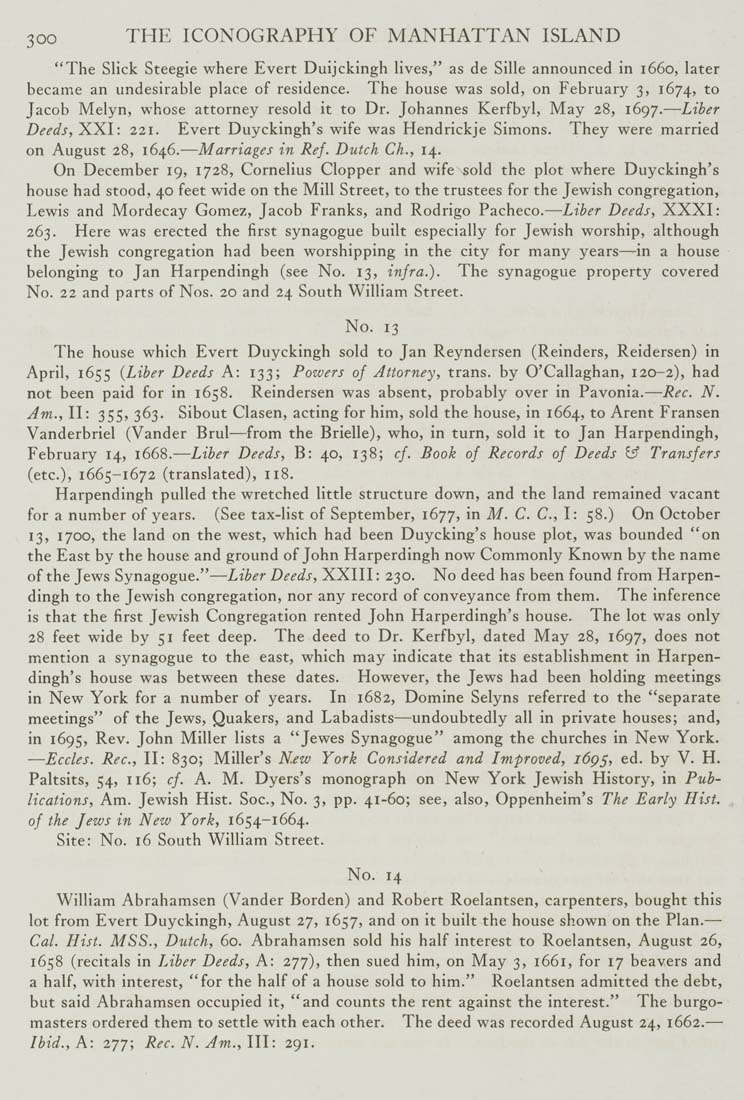300 THE ICONOGRAPHY OF MANHATTAN ISLAND
"The Slick Steegie where Evert Duijckingh lives," as de Sille announced In i66o, later
became an undesirable place of residence. The house was sold, on February 3, 1674, to
Jacob Melyn, whose attorney resold It to Dr. Johannes Kerfbyl, May 28, 1697.—Liber
Deeds, XXI: 221. Evert Duyckingh's wife was Hendrickje Simons. They were married
on August 28, 1646.—Marriages in Ref. Dutch Ch., 14.
On December 19, 1728, Cornelius Clopper and wife sold the plot where Duyckingh's
house had stood, 40 feet wide on the Mill Street, to the trustees for the Jewish congregation,
Lewis and Mordecay Gomez, Jacob Franks, and Rodrlgo Pacheco.—Liber Deeds, XXXI:
263. Here was erected the first synagogue built especially for Jewish worship, although
the Jewish congregation had been worshipping In the city for many years—In a house
belonging to Jan Harpendlngh (see No. 13, infra.). The synagogue property covered
No. 22 and parts of Nos. 20 and 24 South William Street.
No. 13
The house which Evert Duyckingh sold to Jan Reyndersen (Relnders, Reidersen) In
April, 1655 (Liber Deeds A: 133; Powers of Attorney, trans, by O'Callaghan, 120-2), had
not been paid for in 1658. Relndersen was absent, probably over in Pavonia.—Rec. N.
Am., II; 355, 363. Sibout Clasen, acting for him, sold the house, in 1664, to Arent Fransen
Vanderbrlel (Vander Brul—from the Brielle), who, In turn, sold it to Jan Harpendlngh,
February 14, 1668.—Liber Deeds, B: 40, 138; cf. Book of Records of Deeds y Transfers
(etc.), 1665-1672 (translated), 118.
Harpendlngh pulled the wretched little structure down, and the land remained vacant
for a number of years. (See tax-list of September, 1677, In M. C. C, I; 58.) On October
13, 1700, the land on the west, which had been Duycklng's house plot, was bounded "on
the East by the house and ground of John Harperdingh now Commonly Known by the name
of the Jews Synagogue."—Liber Deeds, XXIII; 230. No deed has been found from Harpen¬
dlngh to the Jewish congregation, nor any record of conveyance from them. The Inference
Is that the first Jewish Congregation rented John Harperdingh's house. The lot was only
28 feet wide by 51 feet deep. The deed to Dr. Kerfbyl, dated May 28, 1697, does not
mention a synagogue to the east, which may indicate that its establishment In Harpen-
dingh's house was between these dates. However, the Jews had been holding meetings
in New York for a number of years. In 1682, Domine Selyns referred to the "separate
meetings" of the Jews, Quakers, and Labadists—undoubtedly all In private houses; and.
In 1695, Rev. John Miller lists a "Jewes Synagogue" among the churches in New York.
—Eccles. Rec, II; 830; Miller's New York Considered and Improved, l6g^, ed. by V. H.
Paltsits, 54, 116; cf. A. M. Dyers's monograph on New York Jewish History, in Pub¬
lications, Am. Jewish Hist. Soc, No. 3, pp. 41-60; see, also, Oppenhelm's The Early Hist,
of the Jews in New York, 1654-1664.
Site: No. 16 South William Street.
No. 14
William Abrahamsen (Vander Borden) and Robert Roelantsen, carpenters, bought this
lot from Evert Duyckingh, August 27, 1657, and on It built the house shown on the Plan.—
Cal. Hist. MSS., Dutch, 60. Abrahamsen sold his half Interest to Roelantsen, August 26,
1658 (recitals in Liber Deeds, A: 277), then sued him, on May 3, 1661, for 17 beavers and
a half, with interest, "for the half of a house sold to him." Roelantsen admitted the debt,
but said Abrahamsen occupied It, "and counts the rent against the Interest." The burgo¬
masters ordered them to settle with each other. The deed was recorded August 24, 1662.—
Ibid., A: 277; Rec. N. Am., HI: 291.
|








